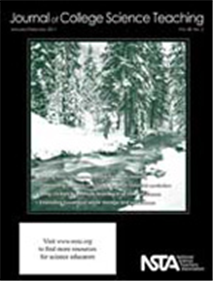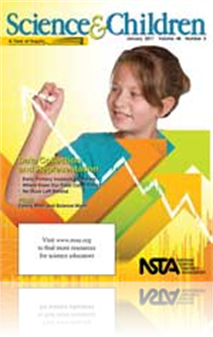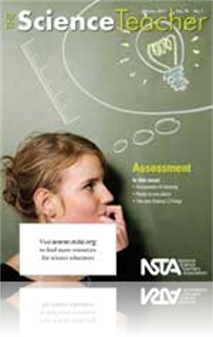All Resources
Journal Article
In this study, the authors describe a Performance Enhanced Interactive Learning (PEIL) workshop model as a supplement for organic chemistry instruction. This workshop model differs from many others in that it includes public presentations by students...
Journal Article
Every Day Science: January 2011
This monthly column presents facts and challenges for the science explorer. ...
Journal Article
The Affective Elements of Science Learning
Student attitudes can have a positive or negative effect on learning. According to Duschl, Schweingruber, and Shouse, “[students’] goals for science learning, their beliefs about their ability to do science, and the value they assign to science l...
Journal Article
Where Does Our Food Come From?
Problem-based learning (PBL) is one approach to teaching science that supports the notion that students construct knowledge within contextual settings, and that critical thinking and application are best fostered within these realistic contexts. In o...
Journal Article
Connecting Students to Science Through Structured Reading of Historical Nonfiction
Success for many of our students is contingent on the degree to which they identify with and make personal connections to science. Although this may be most true of our nonmajors, it is important for us as science educators to help all our students c...
Journal Article
Using Formative and Alternative Assessments to Support Instruction and Measure Student Learning
Using formative assessment involves gathering data from students on their progress and comprehension so that instruction can be adjusted to meet their learning needs (Popham 2001; Greenstein 2010). This article describes how the author uses homework,...
Journal Article
Safer Science: Building Safety in Foreign Language
A school is about to undergo major renovations and new construction to handle a growing student population. So some science classes and labs are assigned to other parts of the building temporarily. Most teachers are excited about the opportunity to h...
Journal Article
The Concept Attainment Strategy
The concept attainment lesson, recommended by Joyce, Weil, and Calhoun (2004), is designed to give students practice in analyzing data and developing critical-thinking skills—without a complicated lab setup. The inductive lesson structure leads stu...
Journal Article
Favorite Demonstration: Cheap Mirrors—Image Construction With Mylar Mirrors and Whiteboards
The cylindrical mirrors lab described in this demonstration has been done in many forms. However, because of its ease in construction and variation, this version allows students to do the exercise themselves, thereby capturing that sense of confidenc...
Journal Article
This article describes how middle school teachers can improve students’ science performance using video games that incorporate principles of the Universal Design for Learning (UDL) framework. Research indicates that video games can enhance the educ...
Journal Article
How Much Carbon Is in the Forest?
At the start of an integrated Algebra I and Environmental Science class, students were presented with the following challenge: “How much carbon is stored in the Normanskill Preserve?” They were told they had one month to investigate and present t...
Book Chapter
The key to mastery learning is that students are required to show mastery of a concept before they are allowed to move on to the next concept. The teacher determines at what level the mastery must be accomplished—for example, 100%, 80%, or 70%. Stu...
Journal Article
Recently, a group of fourth graders joined Pintail Partners—a year-long collaborative research effort of scientists, students, classroom teachers, preservice teachers, museum educators, and university professors. Students and teachers followed sate...
Journal Article
Scope on Safety: Black lights—Don’t be in the dark
Some middle school science teachers take advantage of black light technology phenomena and fluorescent materials in classroom demonstrations and laboratory investigations. Should they be concerned about students working with or being exposed to this ...
Journal Article
Early Primary Invasion Scientists
“We really need to get the government involved,” said one student, holding his graph up to USDA scientist Steve Seefeldt. Dr. Steve studies methods to control invasive plants, plants that have been introduced to an area by humans and have potenti...







